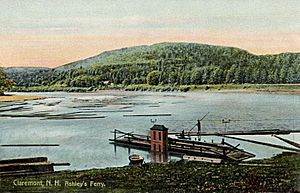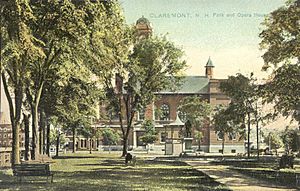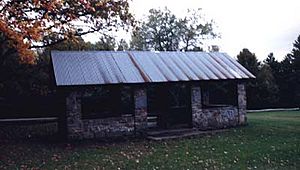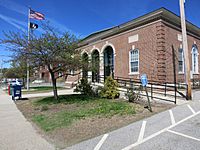Claremont, New Hampshire facts for kids
Quick facts for kids
Claremont, New Hampshire
|
|
|---|---|
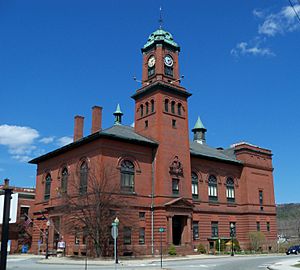
|
|

Location in Sullivan County and the state of New Hampshire
|
|
| Country | United States |
| State | New Hampshire |
| County | Sullivan |
| Settled | 1762 |
| Incorporated | 1764 (town), 1947 (city) |
| Villages |
|
| Area | |
| • Total | 44.05 sq mi (114.09 km2) |
| • Land | 43.15 sq mi (111.77 km2) |
| • Water | 0.90 sq mi (2.32 km2) 2.04% |
| Elevation | 551 ft (168 m) |
| Population
(2020)
|
|
| • Total | 12,949 |
| • Density | 300.07/sq mi (115.86/km2) |
| Time zone | UTC−5 (EST) |
| • Summer (DST) | UTC−4 (EDT) |
| ZIP code |
03743
|
| Area code(s) | 603 |
| FIPS code | 33-12900 |
| GNIS feature ID | 866173 |
Claremont is the only city in Sullivan County, New Hampshire, United States. It's located in the western part of the state, right next to the Connecticut River. In 2020, about 12,949 people lived there. Claremont is a main city in a larger area that includes parts of New Hampshire and Vermont.
Contents
History of Claremont
Early Native American Life
Long before European settlers arrived, the Connecticut River Valley was home to Native American groups. These included the Pennacook and Western Abenaki peoples. They later joined with other Algonquin tribes. The Hunter Archeological Site near Claremont shows that people lived here as early as 1300 CE. This site has evidence of at least three large longhouses.
Colonial Settlement Begins
Claremont was named after a country house in England called Claremont. This house belonged to Thomas Pelham-Holles, who was an important Earl. In 1764, colonial governor Benning Wentworth officially granted the land for the town.
The first settlers, Moses Spafford and David Lynde, arrived in 1762. More families came in 1767, many from Connecticut. The land was good for farming. Moses Spafford was the first person to get married in Claremont, and his son, Elijah, was the first white child born there.
Two very old churches are in Claremont. The Union Episcopal Church, built in 1773, is the oldest Episcopal church building in New Hampshire. It's also the oldest building in the state built just for religious use. Nearby, Old St. Mary's Church, built in 1823, was the first Roman Catholic church in New Hampshire.
During the American Revolution, some people in Claremont supported the British. They would hide from the Patriots in a wooded area called "Tory Hole." Claremont even tried to join the Vermont Republic several times in 1777.
Claremont's Industrial Growth
Claremont grew a lot during the Industrial Revolution. This was thanks to the Sugar River. The river's water power helped run many factories. Colonel Benjamin Tyler built the first mill on the Sugar River in 1767. He also invented a special water wheel. His grandson, John Tyler, improved this technology. John Tyler's grandson, Benjamin Tyler Henry, invented the Henry Repeating rifle. This rifle was used in the American Civil War.
Large brick factories were built along the river. They made things like cotton and woolen textiles, machines, and paper. Even though many factories closed in the 1900s, you can still see beautiful Victorian architecture from that time. The city hall and opera house, built in 1897, is a great example.
By 1874, Claremont had many busy businesses. These included the Monadnock Mills, which made cotton cloth, and the Sullivan Machine Co., which made drilling machinery and water wheels. Other companies made paper, books, leather goods, and sashes and doors.
The Monadnock Mills and Sullivan Mills were very important. Monadnock Mills made textiles until 1932. Sullivan Mills became New Hampshire's largest machining company. It was Claremont's biggest employer until the 1970s. The company later merged with Joy Mining Machinery and became Joy Manufacturing Co.
Important Education Milestones
In the 1850s, Claremont wanted to build a public high school. At that time, New Hampshire didn't have public high schools. The state agreed to let Claremont build one, and then allowed all other towns to do the same. A local businessman, Paran Stevens, helped fund Stevens High School.
Later, in 1989, the Claremont School Board sued the State of New Hampshire. They argued that relying mostly on local property taxes for school funding was unfair. This meant some children had fewer educational opportunities. The New Hampshire Supreme Court agreed. This case, known as the "Claremont Decision," still affects how schools are funded in New Hampshire today.
Cities Named After Claremont
Several other places in the United States were named after Claremont, New Hampshire. These include Claremont, California, Claremont, Minnesota, and Claremont Township, Minnesota.
Claremont's Geography
Claremont is in western Sullivan County, New Hampshire. The Connecticut River forms its western border with Vermont. The city covers about 44 square miles (114 square kilometers). Most of this is land, with a small amount of water. The Sugar River flows through the middle of Claremont. It drops about 150 feet as it goes through downtown before joining the Connecticut River. The highest point in Claremont is Green Mountain, which is 2,018 feet above sea level.

Neighboring Towns
Claremont is next to several other towns:
- Cornish (north)
- Newport (east)
- Unity (southeast)
- Charlestown (southwest)
- Weathersfield, Vermont (west)
Claremont's Population
| Historical population | |||
|---|---|---|---|
| Census | Pop. | %± | |
| 1790 | 1,435 | — | |
| 1800 | 1,889 | 31.6% | |
| 1810 | 2,094 | 10.9% | |
| 1820 | 1,702 | −18.7% | |
| 1830 | 2,526 | 48.4% | |
| 1840 | 3,217 | 27.4% | |
| 1850 | 3,606 | 12.1% | |
| 1860 | 4,026 | 11.6% | |
| 1870 | 4,053 | 0.7% | |
| 1880 | 4,704 | 16.1% | |
| 1890 | 5,565 | 18.3% | |
| 1900 | 6,498 | 16.8% | |
| 1910 | 7,529 | 15.9% | |
| 1920 | 9,524 | 26.5% | |
| 1930 | 12,377 | 30.0% | |
| 1940 | 12,144 | −1.9% | |
| 1950 | 12,811 | 5.5% | |
| 1960 | 13,563 | 5.9% | |
| 1970 | 14,221 | 4.9% | |
| 1980 | 14,557 | 2.4% | |
| 1990 | 13,902 | −4.5% | |
| 2000 | 13,151 | −5.4% | |
| 2010 | 13,355 | 1.6% | |
| 2020 | 12,949 | −3.0% | |
| U.S. Decennial Census | |||
In 2010, Claremont had 13,355 people living there. There were about 5,697 households. Most people (95.9%) identified as White. About 22% of the population was under 18 years old. The average age in Claremont was about 40.6 years.
Arts and Culture in Claremont
Claremont's main shopping area is on Washington Street. The beautiful Italian Renaissance-style City Hall building, built in 1897, is home to the historic Claremont Opera House. City Hall faces Broad Street Park, which is a large town square.
Broad Street Park has monuments for soldiers from World War I, World War II, the Korean War, and the Vietnam War. There's also a Freedom Garden Memorial for the victims of September 11. The park has two Civil War cannons and a central Soldier's Monument from 1890. A historic bandstand in the park is used for performances by the Claremont American Band, which started around 1880.
Many old mill buildings are in the Lower Village District along the Sugar River. Efforts have been made to preserve some of these historic buildings.
On the south side of Claremont, you'll find Moody Park. This park was donated to the city in 1916 by William Henry Harrison Moody, a successful businessman from Claremont. The park has tennis courts and miles of walking trails through forests. There's also a large open field with a stone picnic structure at the top of a hill.
In 2021, the Ko'asek (Co'wasuck) Traditional Band of the Sovereign Abenaki Nation, a group of descendants of the area's original people, received land in Claremont. They use this land for cultural ceremonies, nature preserves, education, and growing traditional plants. In 2024, the group had 554 members and owned over 26 acres in Claremont.
Fun Places to Visit
- Arrowhead Recreation Area
- Claremont Historical Society & Museum
- Claremont Municipal Airport
- Sugar River Rail Trail
- Twin State Speedway
Historic Places to See
- Claremont Opera House
- David Dexter House
- Hunter Archeological Site
- Lower Village Historic District
- Monadnock Mills Historic District
- Union Episcopal Church
- William Rossiter House
Education in Claremont
Claremont is part of New Hampshire's School Administrative Unit 6 (SAU 6). Stevens High School is the city's only public high school. Claremont Middle School is the city's only public middle school.
Claremont has three elementary schools: Maple Avenue School, Bluff Elementary, and Disnard Elementary. There are also private schools like New England Classical Academy (a Catholic school) and Claremont Christian Academy.
For higher education, Claremont has a branch of Granite State College, River Valley Community College, and the Sugar River Valley Regional Technical Center.
Claremont's Transportation
Claremont is the only city in Sullivan County. It has its own airport, Claremont Municipal Airport. If you're traveling by car, it's about 21 miles south of Interstate 89 and 5 miles east of Interstate 91. Several state routes serve the city, including Route 11, Route 12, Route 12A, Route 103, and Route 120.
Amtrak, the national passenger train system, offers daily service on its Vermonter train. This train travels between Washington, D.C. and St. Albans, Vermont. The closest Greyhound bus stops are in nearby towns. There's also a local bus service that runs on weekdays between Springfield, Vermont, and Hanover, New Hampshire.
Notable People from Claremont
- Doug Berry (born 1948), football coach
- Edmund Burke (1809–1882), U.S. congressman
- Barbara Cochran (born 1951), Olympic gold medalist ski racer
- Caleb Ellis (1767–1816), U.S. congressman
- Harriet Farley (1812–1907), writer and abolitionist
- Kirk Hanefeld (born 1956), golfer
- Benjamin Tyler Henry (1821–1898), gunsmith and inventor of the Henry rifle
- Jeffrey R. Howard (born 1955), judge
- Jonathan Hatch Hubbard (1768–1849), U.S. congressman
- Dorothy Loudon (1925–2003), actress
- Larry McElreavy (born 1946), college football coach
- Jennifer Militello, poet
- Hosea Washington Parker (1833–1922), U.S. congressman
- Kaleb Tarczewski (born 1993), basketball player
- William J. Wilgus (1865–1949), designer of New York City's Grand Central Terminal
- Constance Fenimore Woolson (1840–1894), novelist
Images for kids
See also
 In Spanish: Claremont (Nuevo Hampshire) para niños
In Spanish: Claremont (Nuevo Hampshire) para niños


